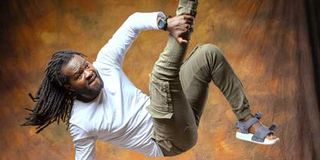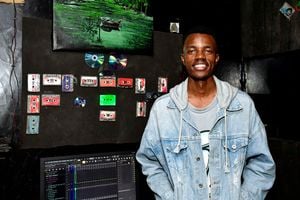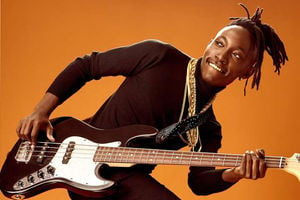
Breakdancer Victor Onyango (B-Boy Vic), founder of Slum Dance Africa. He has been selected by the French Embassy to take part in the Olympic Breakdance Competition in Paris in August.
The inclusion of breakdancing as a new sport during the Paris Olympics was big news for the thriving community of breakers in Kenya. As the world’s top breakdancers are competing for honours in Paris, a new generation of Kenyan breakers were battling it out in Nairobi at an event titled Breaking Mtaani, last Saturday, August 3.
The b-boys and b-girls took to the floor to show off their intricate, agile moves in one-on-one battles that dazzled the crowd and offered a showcase of the depth of breaking talent in Nairobi.

Victor Onyango (B-Boy Vic), founder of Slum Dance Africa, attended the Olympics Breakdance competition in Paris, courtesy of the French Embassy in Nairobi.
Steve Bulinda Kiboga (B-boy Grimm), 18, winner of the main category during Breaking Mtaani started off as a gymnast then joined the Mviringo Breaking Academy in Kangemi during the Covid-19 lockdown.
“I went to Kangemi Social Hall and I found dancers. I initially thought they were acrobats, but I learnt the skill of breaking and started training,” he says.
The Form 4 student at Kabete Vet Lab Secondary School, has won a host of battles, including the 2021 Awakening 7 to Smoke (beating all competitors all in one go, seven points without losing a battle), and the 2022 Kenya Breaking Battle organised by London-based collective Floor Rippers.
“I am self-motivated, so when I get on the dance floor no one can challenge me,” he says, confidently. He has recently formed his own crew called Ruff Kidz Era, comprising 10 dancers.
The Mviringo Academy is the brainchild of Eric Gitau (B-Boy G), 39, one of the judges during the
Breaking Mtaani event. Gitau started breaking in 2004 after watching the American film, You Got Served, based on a group of dancers who take part in a street dancing competition.
“I started watching YouTube videos and practicing moves seriously,” he says.
“One day we performed at a church in Uthiru and the reaction from people in attendance was ‘Wow! How did you spin like that with your head upside down’”, he recalls.
Soon afterwards, opportunities opened for his crew Sisqo Reloaded to perform at the Florida Nightclub jam sessions in Nairobi, a popular afternoon entertainment program that included a talent showcase.

Breakdancer Victor Onyango (B-Boy Vic) founder of Slum Dance Africa. He has been chosen by the French Embassy to attend the Olympics Breakdance competition in Paris on August 9-10.
In 2016, Gitau and his brother, George Ritho (B-Boy Mike) formed an academy to train youngsters in their community on the art of breakdancing.
“We called it Mviringo because every breaking motion is circular, always rotating,” explains Gitau.
“It is registered as a community based organisation and most of the children we currently train are between 14 and 18 years of age, drawn not just from Kangemi area but also Westlands, Lower Kabete, Thika and Kikuyu. It is not just the youth, we also get adults who are in their 40s and 50s coming to practice breaking,” he says.
The registration fee is Sh1000, with each session at the academy costing Sh200. The lessons include the standard breaking moves like the backspin, head spin, the headstand and the windmill.
“I love combining the windmill with the swipes, then I spin and freeze while on my head. Now that schools are closed, we have practice sessions every day,” he says.
B-boy Mikey also trains dancers at the Chinese Cultural Centre in Lavington, Nairobi and says that there is a lot of work to be done before Kenyan breakers attain the highest standards in the world.
“It is a good thing we are not at the Olympics because our breakers have not trained at the highest level. We must invest in local coaches and judges; dancers must-have safety gear. We need to register a federation and then we can begin to formally organise workshops for talent and cyphers which will create awareness among the public. A cypher is a gathering of breakers, often on the street, battling before a crowd of spectators.
However, Gitau was impressed by the level of competition during last week’s battle.
“There were so many dancers, including girls with great skills and we loved the originality and improvisation, including one dancer who fused his breaking steps with a drunken master imitation. The potential for success is huge.”
“Breaking is all communication, and when you see gestures like one dancer tapping the floor during a battle, then it means his rival crashed a move. When you count your fingers, it means that your rival has repeated a move. As judges, we are alert to spot if the breakers are just copying moves from YouTube videos or are using their imagination to create original steps,” he says.

Victor 32, says breaking was therapeutic after the post-election violence in 2007-08 when his home in Kibera was the epicentre of the chaos.
Two leading Kenyan breakers, Victor Onyango (B-boy Vic) and Omondi Joseph Milla (B-Boy Drift) have travelled to France this week to attend the Olympics Breakdancing competition.
Victor says the trip is a learning experience while also offering them an opportunity to pitch for Kenya and Africa’s strategic place in the development of breakdancing as a global culture.
“My message is that this is Africa’s time because the young generation have the numbers, the passion and the hunger. This is a potential job creator through dance and breaking so investors should flock to Africa,” he says.
From Paris, he will then travel to the Netherlands, Slovakia Finland and Germany to network with the global DanceSport community. Last May, Milla (B-Boy Drift) attended the WDSF African Breaking Championships in Rabat, Morocco, the continental qualifier for Paris 2024, along with George Kaminju (B-boy Jijo/Mzushiafrica). Kaminju, who started breaking in 2012, has gained wide international exposure, representing Kenya at events in Uganda, France and Morocco.
During pre-selection in Morocco last year, he narrowly missed finishing in the Top 16, which would have put him through to the final stage of the Olympic qualifiers. The Pumwani, Majengo resident established a community outreach programme called King of the Street, to offer meaningful livelihoods to the youth through breakdancing.
“I started breaking at age 21, but the children we saw at the Breaking Mtaani battle have started very young and they can go much further than we have, with the right structures and support,” says the dancer, who got his big break during the TV reality show Sakata Dance.
He credits breaking as having offered young people in his community an alternative lifestyle at a time when many of their peers were being radicalised to join terror groups.
“Dancing kept many (young) people engaged and away from the temptation of joining such groups. There was also an influx of heroine and the pushers were very apprehensive when they saw us dancing in spaces that they used to occupy while dealing their trade, so they left.”

Eric Gitau(left) and Steve Bulinda Kiboga under project Mviringo Breaking Academy, showcase their dance moves at Alliance Francaise, Nairobi on August 8, 2024.
For Victor (B-Boy Vic), 32, breaking was therapeutic during and after the post-election violence in 2007-08 when his home in Kibera was the epicenter of the bloody events. His first group was a crew of six hip-hop dancers during the first season of the Sakata TV show.
“No one understood what we were doing, so, together with my brother, we started street shows in our neighbourhood. I was passionate, and some people even said what we were doing was cultism, while the local area chief thought we were selling drugs. But I didn’t give up,” he recalls.
His breakthrough came during the 2013 Beat Ya Street on NTV when his group of dancers reached the quarter-finals.
“Even the area chief who had called us criminals was watching and was astonished,” he says.
Onyango started Slum Dance Kibera for classes, public performances and an annual competition that evolved into Slum Dance Kenya, and eventually, with participation of all East and Central African countries, is Slum Dance Africa. His academy has a total of 60 dancers, half of whom he classifies as really good.
“We are keen on girl’s empowerment by creating a safe space for girls to participate in breaking and other contemporary dance,” he notes.
In April this year, the top breakers like B-boy Jijo and B-Boy Vic were involved in Break Ma County, a project that involved training and competitions in 24 counties, with the support of the French Embassy in Kenya to popularise the sport across Kenya.

Eric Gitau (in white T-shirt) and Steve Bulinda Kiboga under project Mviringo Breaking Academy, showcase their dance moves at Alliance Francaise, Nairobi on August 8, 2024.
Despite having been a breaker for more than a decade, Kaminju (B-Boy Jijo) says that the current situation is such that structures must be established to support breakdancing as a viable career. Meeting the criteria for registration of a national federation for dance sport in Kenya, affiliated to the World Dance Sport Federation is the current priority.
Facilities such as padded dance floors for training and competitions and dancers must have access to protective gear such as knee guards to protect them from injuries. Just as with other sports, breakdancing requires the expertise of physiotherapists, medics, coaches, and access to a well-equipped gymnasium.
Fresh from his latest battle triumph, B-Boy Grimm is optimistic about the future for breakers in Kenya.
“The standards are rising because at the beginning there were no female breakers, but look at the number that we have here today. Breaking is easy, you just need lots of practice,” he says while showing off his signature move: a breathtaking one-hand spin followed by a freeze. He calmly says, “My ambition is to keep winning and make a mark on the international stage.”






